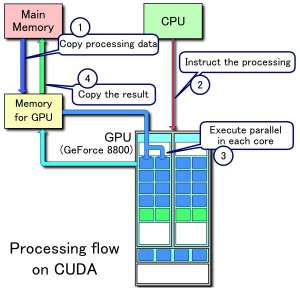CUDA
In modern computer graphics we can only show what we can count in a reasonable time. Therefore, the primary restriction are the the possibility of hardware and computing power.
To improve the rendering capabilities of graphics Nvidia company in 1999 introduced a GPU (Graphics Processing Unit), whose main task was to perform calculations related to 3D graphics, which resulted in partial relief of the CPU. As a result increased system performance.
Another solution for better use of computing power in computer graphics is CUDA.
CUDA (Compute Unified Device Architecture) is a parallel computing architecture developed by Nvidia for graphics processing. In the computer game industry, in addition to graphics rendering, GPUs are used in game physics calculations. CUDA has also been used to accelerate non-graphical applications in computational biology, cryptography and other fields by an order of magnitude or more. CUDA has several advantages over traditional general-purpose computation on GPUs (GPGPU) using graphics APIs, e.g. cattered reads, shared memory, faster downloads and readbacks to and from the GPU, full support for integer and bitwise operations, including integer texture lookups.
Other solutions are the Larrabee processor and AMD FireStream.
Sample processing course in CUDA:
1. Copy processing data.
2. Instruct the processing.
3. Execute paralell in each core.
4. Copy the result.
CUDA gives developers access to the virtual instruction set and memory of the parallelcomputational elements in CUDA GPUs. Using CUDA, the latest Nvidia GPUs become accessible for computation like CPUs. Unlike CPUs however, GPUs have a parallel throughput architecture that emphasizes executing many concurrent threads slowly, rather than executing a single thread very quickly.
Summary
CUDA is parallel computing architecture that delivers a radical performance boost due to use of GPU computing. For applications of this technology we can include video processing, astrophysics, computational biology, chemistry, fluid dynamics simulation, electromagnetic interference testing, image reconstruction in computed tomography, robot design, traffic safety, seismic analysis, ray tracing, and much more.
Parent page: CUDA





